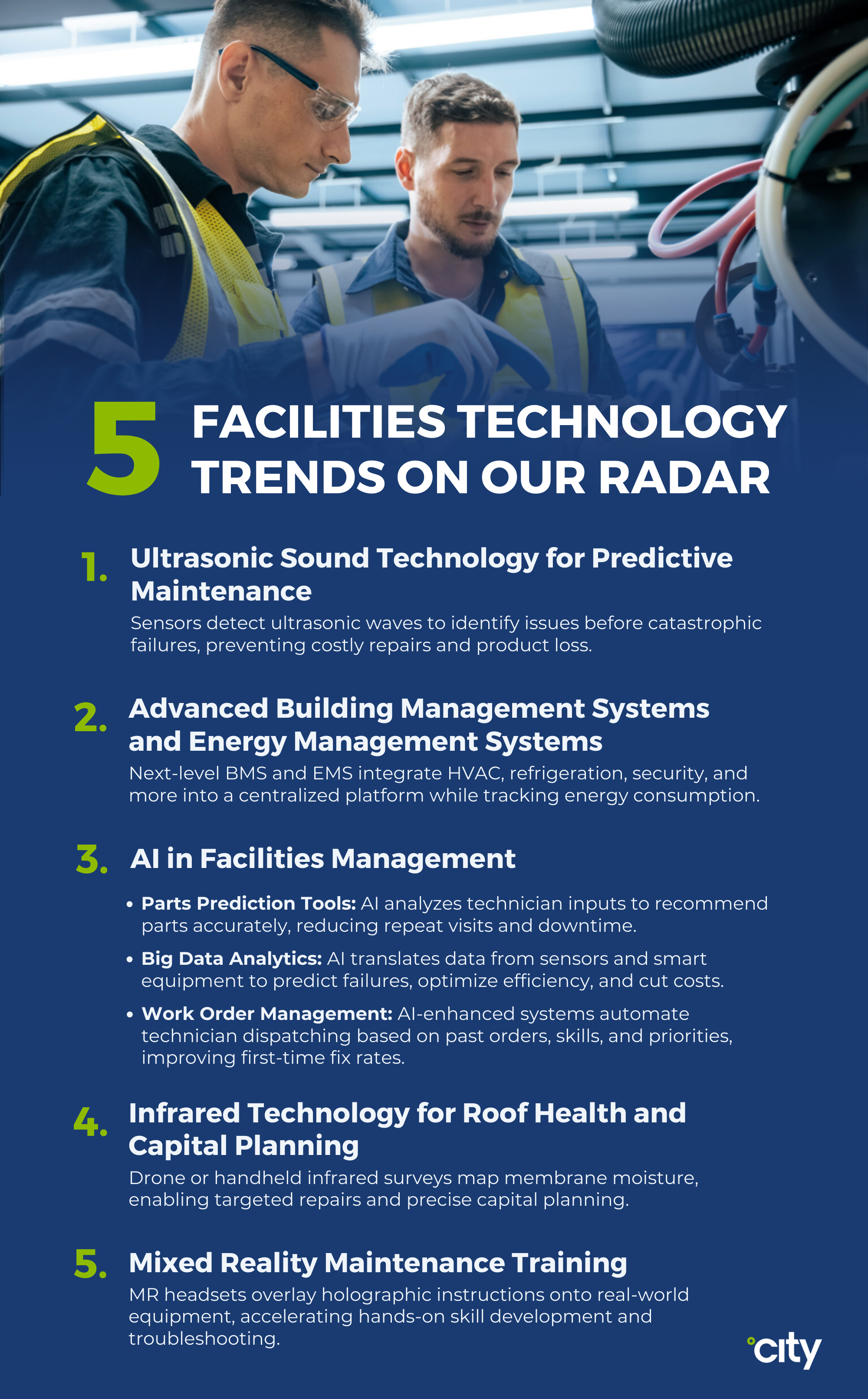
Driven by advancements in data analytics, smart building technologies, and a focus on sustainability, facilities management will continue to rapidly evolve in 2025. With climate goals growing increasingly ambitious (94% of survey respondents are looking to prioritize renewable energy projects) and a stronger push for operational efficiency than ever before, AI and other innovative solutions are stepping in to help facilities teams power their success.
For an insider look at the most impactful trends for grocery stores, convenience stores, and other food retailers to embrace in the year ahead, we spoke with Cristee Monahan, VP of Central Operations for City, and Erick Brown, Director of Energy for City.
Keep reading for the most exciting tech developments facilities managers should have on their radar in 2025, from automated maintenance to AI-powered energy management. With the right adoption strategy, these solutions can help lower costs, increase revenue, reduce environmental impact, and give organizations a critical edge.

What Are Facilities Management Technologies?
Facilities management technologies refer to the various hardware and facility management software solutions designed to optimize the functionality and efficiency of buildings and physical infrastructure. They tie together critical systems related to maintenance, energy use, space utilization, and more.
Some examples of FM technologies include:
- Computerized Maintenance Management Software (CMMS): Tracks maintenance schedules, spare parts inventories, asset warranties, and more
- Building Automation Systems (BAS): Remotely monitors and controls HVAC, lighting, access control, and other systems
- Energy Management Systems (EMS): Analyzes energy usage patterns to reduce consumption and costs
- Sensor networks and IoT devices: Collects granular data on temperature, occupancy, equipment performance, etc.
- Asset management solutions: Manages inventory, utilization, and maintenance of physical assets
- Integrated Workplace Management Systems (IWMS): Consolidates siloed data sources, such as maintenance logs, space utilization metrics, and energy consumption data, for holistic visibility
- AI and machine learning: Uncovers hidden insights in vast datasets to inform strategic decisions
With the exponential growth of data and connectivity, the FM tech landscape is continually expanding. The central value of FM technologies is to provide actionable insights and enable automation so that facilities leaders can proactively address issues, meet sustainability objectives, and enable their built environments to efficiently serve facilities management goals.

Facility Management Technology Trends to Embrace in 2025
With innovation advancing at an astonishing pace, a number of new technologies have emerged in the facilities management space in recent years. Facilities managers who embrace early adoption and are willing to pilot solutions strategically aligned to their needs are more likely to reap rewards in the form of savings, efficiency, and sustainability performance. Here are some of the top ones on Cristee’s and Erick’s radars.
Ultrasonic Sound Technology for Predictive Maintenance
“One of the most exciting technological developments that we’re seeing widespread adoption for is using sound technology for predictive refrigeration maintenance,” says Cristee. “These tools use sensors that detect ultrasonic waves to identify issues before catastrophic failure.” This prevents costly reactive repairs and product losses from spoiled inventory.
For example, City’s SOUNDTech+, an ultrasonic diagnostic system that detects impending equipment failures through machine learning analysis of sound frequencies, has shown 99 percent accuracy in controlled pilots. This enables facilities teams to drastically cut down on diagnostic time and prevent costly equipment downtime.
Advanced Building Management Systems (BMS) and Energy Management Systems (EMS)
Sophisticated BMS and EMS solutions take smart building capabilities to the next level and tie them together in one centralized platform. As Cristee explains, “By integrating controls for things like HVAC, refrigeration, and security, while also providing granular tracking of energy consumption, facilities leaders gain holistic visibility and opportunities for deep optimization.”
By integrating controls for things like HVAC, refrigeration, and security, while also providing granular tracking of energy consumption, facilities leaders gain holistic visibility and opportunities for deep optimization.Cristee Monahan, VP of Central Operations for City
From remote equipment adjustments to utility bill validation, these intelligent systems are a must-have. An EPA report noted that a 10 percent reduction in energy costs can result in a 16 percent increase in profit margin. Their open architecture also allows for integration with predictive maintenance data, edge sensors, and next-generation technologies.
AI in Facilities Management
With its ability to rapidly process vast amounts of data and uncover hidden insights, artificial intelligence is proving to be an essential tool for facilities management teams looking to enhance operational efficiency, lower costs, and meet sustainability goals. Here are some trending AI facilities management trends:
● AI-powered parts prediction tools
When it comes to streamlining maintenance operations, AI is proving invaluable by enhancing parts fulfillment processes. “With some basic upfront data from technicians, AI-powered systems can make impressively accurate parts recommendations,” says Cristee. “This drastically cuts down on repeat site visits and helps get units back up faster.”
How it works: AI processes inputs like equipment symptoms and error codes against a vast database to produce what Cristee has observed to be amazingly accurate suggestions. To maximize the benefits of this technology, FM teams should actively seek out service providers that utilize AI-enhanced parts fulfillment processes. Suppliers with advanced algorithms that can predict necessary spare parts will save critical time in maintenance jobs.
● AI for big data analytics
With sensors and smart equipment producing vast amounts of data across retail sites, AI is proving invaluable for translating numbers into meaningful strategies. As Erick explains, advanced algorithms can rapidly analyze energy usage, temperature patterns, refrigeration cycles, and other operational data streams to pinpoint potential equipment failures before they occur, adjust baselines to optimize efficiency, and more. This can lead to dramatic reductions in downtime and maintenance costs.
● AI in work order management systems
AI is also enhancing work order management platforms that are used for coordinating maintenance jobs, technicians, and parts fulfillment. By considering past work orders, technician skills and availability, job complexity, and priority levels, these systems can automatically dispatch technicians for optimal response efficiency. This technology is driving significant improvements in first-time fix rates, says Cristee.
Infrared Technology for Roof Health and Capital Planning
Roof integrity is critical for retail sites, but assessing roof health without advanced tech has typically meant core sampling — which comes at a massive expense. But now, infrared surveys using drone or handheld cameras can instantly map membrane moisture levels, enabling targeted repair and replacement while also informing capital planning with precision.
Mixed reality maintenance training
For some time now, the facilities management industry has been grappling with an aging workforce and shrinking labor force. Training programs will play a key role in addressing this by advancing the skills of the next generation of technicians. This is where mixed reality (MR) comes in — by blending real-world physical environments with computer-generated content and interactivity to assist hands-on learning.
While this technology has been slow to gain traction, City sees strong potential in equipping technicians with MR headsets for immersive on-the-job training. By overlaying holographic instructions onto equipment as technicians work on repairs, MR can accelerate skill development in equipment troubleshooting and maintenance. Facilities management teams are beginning to run controlled pilots of these approaches.
Get Ahead of the Technology Curve
With margins tight and expectations high, retailers must leverage technology to maximize efficiency in their facility operations. By staying on top of innovations and running controlled pilots for solutions with clear potential, management teams can pave the way for improved performance and long-term gains.
While piloting innovations like AI-enhanced work order systems, sound analytics for predictive maintenance, and mixed reality training tools involves some initial outlay, the upside in terms of energy savings, reduced service calls, and faster service make them well worth exploring.
As an industry-disruptive facilities management provider powered by data-driven and self-delivery capabilities, City helps retail facility leaders implement the latest innovations to transform service quality, lower costs, and meet ambitious sustainability goals. Learn more about our intelligence and automation capabilities.


 2016: City US is established in North America, in partnership with Southeastern Grocers (SEG), servicing over 750 supermarkets across 7 southern states.
2016: City US is established in North America, in partnership with Southeastern Grocers (SEG), servicing over 750 supermarkets across 7 southern states. 1985: Willie and Susan Haughey establish City Refrigeration Holdings (UK) Ltd in Glasgow, UK.
1985: Willie and Susan Haughey establish City Refrigeration Holdings (UK) Ltd in Glasgow, UK. 2009: City Australia launches in Melbourne, in partnership with Coles, servicing over 700 supermarkets across the country.
2009: City Australia launches in Melbourne, in partnership with Coles, servicing over 700 supermarkets across the country. 2015: City Asia launches in Kuala Lumpur, Malaysia, in partnership with Dairy Farm, servicing over 205 supermarkets across the region.
2015: City Asia launches in Kuala Lumpur, Malaysia, in partnership with Dairy Farm, servicing over 205 supermarkets across the region.